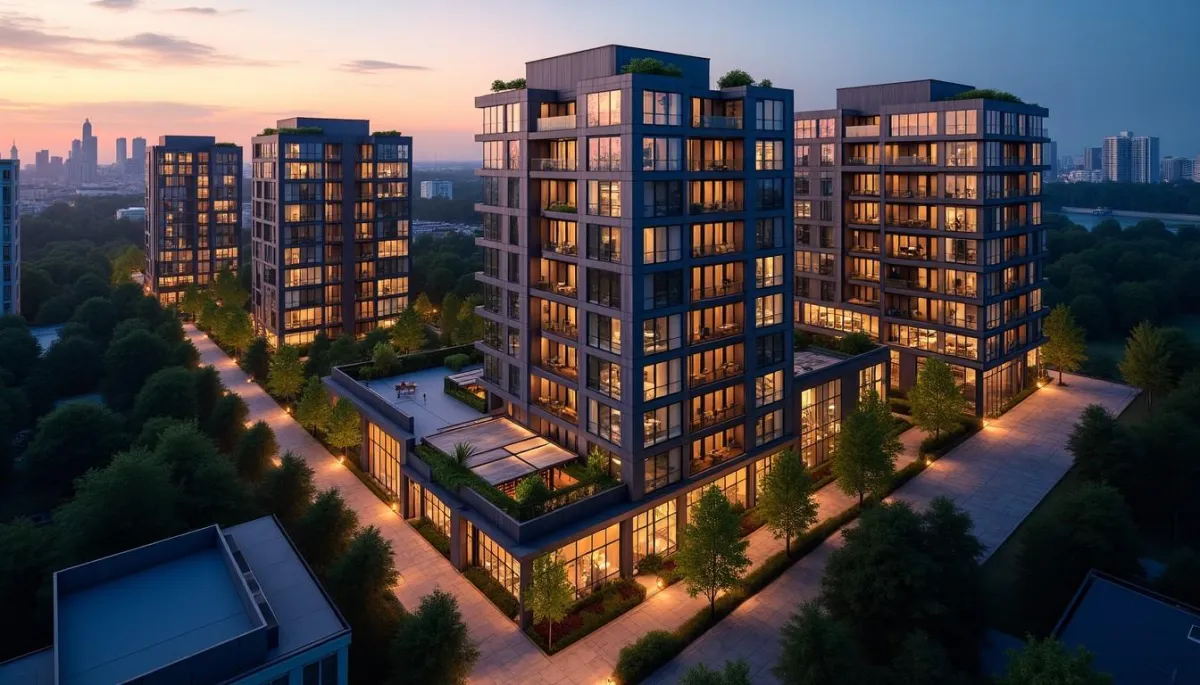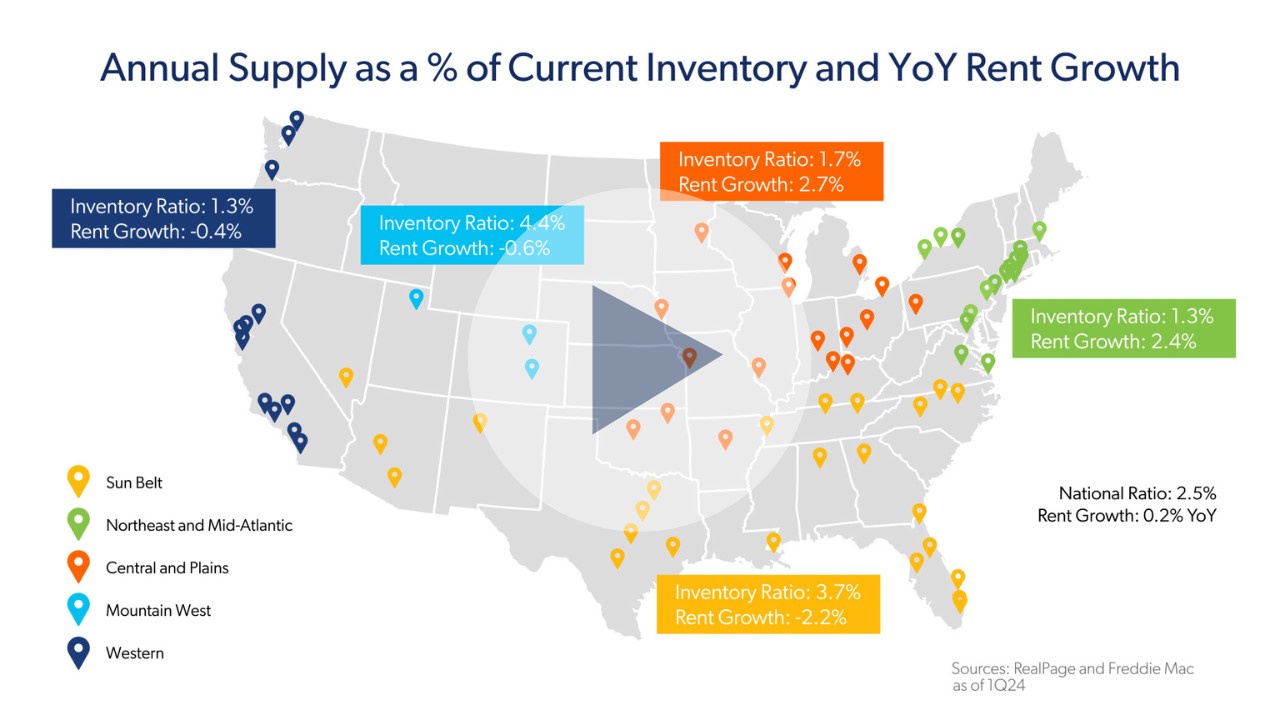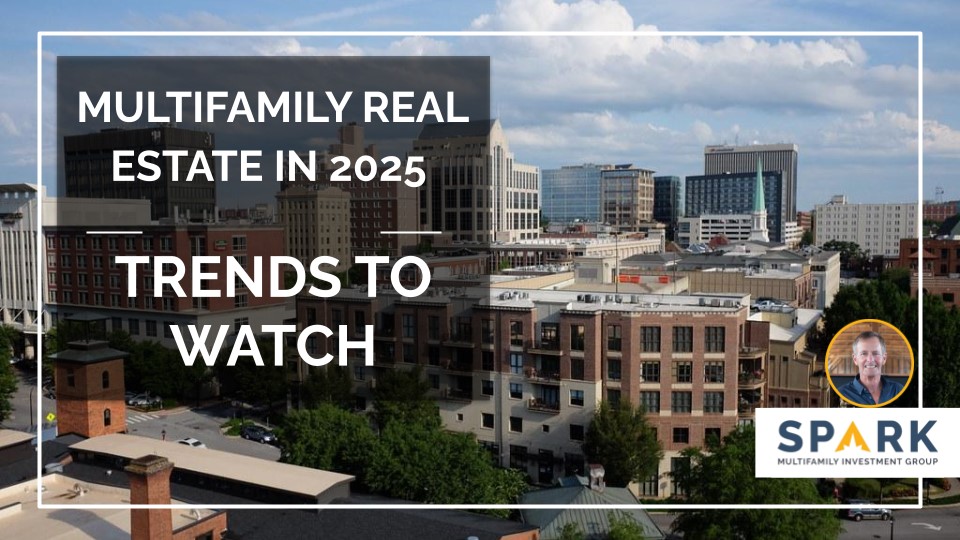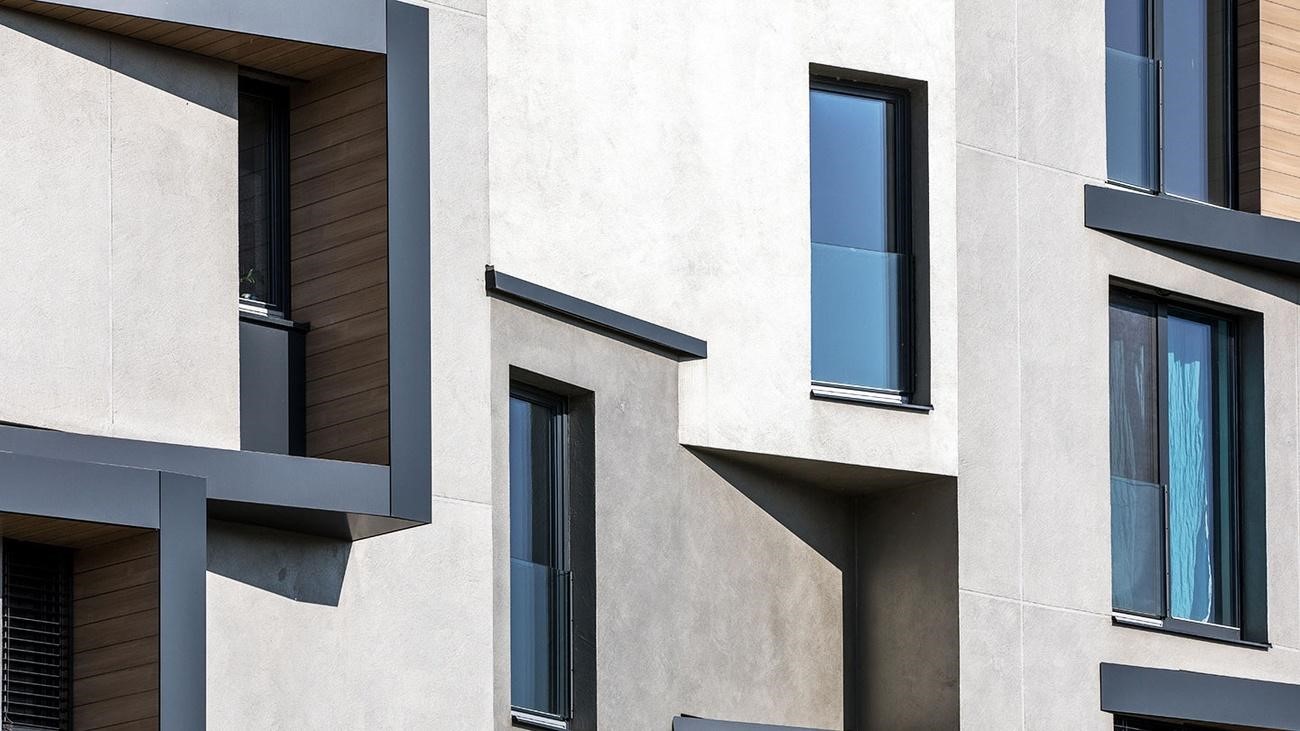
7 Multifamily Real Estate Trends Smart Investors Are Watching for 2025
Multifamily real estate investors face a dramatically different market heading into 2025. While some experts predict a market slowdown, savvy investors are discovering new opportunities in this evolving landscape.
The past year has reshaped traditional investment strategies, with rising interest rates, shifting demographics, and technological advances transforming the real estate investing landscape. However, data shows that multifamily investing continues to offer strong returns for those who know where to look.
From emerging Sun Belt markets to innovative financing solutions, these seven critical trends will shape successful multifamily investments in 2025. Understanding these shifts now could mean the difference between thriving and merely surviving in tomorrow's market.
Rising Interest Rate Impact on Multifamily Investment

Image Source: CRE Daily
Interest rates remain a pivotal factor shaping multifamily real estate investments as we approach 2025. The Federal Reserve's monetary policy decisions continue to influence market dynamics significantly.
Interest Rate Trends and Forecasts
The federal funds rate currently sits between 4.25% and 4.5%, marking a decrease from the 5.25%-5.5% range maintained throughout most of 2023. Specifically, Moody's Analytics projects the federal funds rate to settle around 4% by the end of 2025. Furthermore, the 10-year Treasury yield, a crucial benchmark for multifamily loans, has demonstrated notable volatility, fluctuating between 3.75% and 4.5%.
Impact on Cap Rates and Valuations
Property valuations have experienced significant pressure due to the interest rate environment. Accordingly, multifamily property prices have declined for nine consecutive quarters since mid-2022, showing a total decrease of nearly 20%. The relationship between cap rates and interest rates presents a complex dynamic:
Cap rates have remained relatively stable, operating within a 5.6% to 5.7% range
The cap rate spread sits at approximately 170 basis points, notably below the historic average of 300 basis points
Investment Strategy Adjustments
Consequently, investors are adapting their approaches to navigate this evolving landscape. The multifamily loan origination volume is expected to increase to $320 billion in 2024 and reach $370-380 billion in 2025. Investment strategies now emphasize:
Strategy Component
Focus Area
Asset Selection
Properties with strong fundamentals and stable cash flows
Financing
Creative structures and alternative funding sources
Risk Management
Enhanced due diligence and operational efficiency
The window between interest rate adjustments and cap rate responses, typically six to nine months, creates strategic opportunities for well-positioned investors.
Supply-Demand Dynamics Shift

Image Source: Freddie Mac Multifamily
The multifamily real estate landscape is experiencing an unprecedented supply surge, with a record-breaking 554,000 units projected for completion.
New Supply Pipeline Analysis
The construction pipeline remains substantial, with over 900,000 units underway across the U.S. Indeed, the development activity has reached its highest level since the 1980s. Moreover, Yardi Matrix forecasts indicate an 8.1% increase in supply for 2025, projecting 508,089 units.
Absorption Rate Predictions
Despite initial concerns, absorption rates have demonstrated remarkable resilience. The market absorbed 667,000 units in 2024, notably exceeding expectations. The absorption trends vary across regions:
Northeast and Midwest markets maintain stable occupancy rates of 96.3% and 95.3% respectively
Southern regions show lower occupancy at 93.9%
Market-Specific Supply Impacts
Regional market performance presents striking contrasts. Here's how key markets are responding to supply changes:
Market
Supply Impact
Current Status
Austin
Decreased from 19% to 11% of inventory
Supply stabilizing
Nashville
Reduced from 15% to under 9%
Pipeline shrinking
San Jose
3.5 years of construction remaining
Higher risk profile
The Sun Belt and Mountain West regions face the most significant supply pressure. Additionally, markets like Phoenix, Tampa, and Nashville are experiencing what analysts term a "hangover effect" from post-pandemic growth.
Looking ahead, the construction pipeline is expected to decrease substantially, with new development starts dropping by approximately 50% from 2022-2023 levels. This reduction in future supply suggests a more balanced market environment by 2026.
ESG and Sustainability Focus

Image Source: Spark Investment Group
Sustainability has emerged as a crucial factor driving multifamily real estate investment decisions. The sustainable construction sector is projected to grow at 8.91% annually, reflecting the increasing emphasis on environmental responsibility in property development.
Green Building Requirements
Property developers are adapting to stricter carbon emissions regulations and growing demand for eco-friendly features. In fact, 83% of residents believe living in a sustainable building benefits their health, with 59% willing to pay premium rents for green properties. Key requirements now include:
Biophilic design integration for improved air quality
Water conservation systems
Low-VOC materials for healthier living environments
Electric vehicle charging infrastructure
Energy Efficiency Investments
Energy efficiency remains fundamental to sustainable multifamily properties. Buildings currently contribute 34% of global energy demand, making efficiency improvements particularly valuable. The following table illustrates key investment areas and their benefits:
Investment Area
Primary Benefits
LED Lighting & Sensors
Energy savings, reduced maintenance
Smart Thermostats
Precise temperature control
Enhanced Insulation
Improved energy efficiency
Solar Panel Integration
Reduced carbon footprint
ESG Reporting Standards
As of 2021, over 22,200 REITs now publish ESG data publicly, notably up from just 60 in 2017. The Global Real Estate Sustainability Benchmark (GRESB) has become the primary framework for evaluating environmental performance. Above all, properties with strong ESG scores demonstrate:
26% lower insurance cost increases
Enhanced asset value preservation
Improved access to green financing programs
Better compliance with evolving regulations
In essence, multifamily properties implementing comprehensive ESG strategies are experiencing tangible benefits, as buildings with sustainable features are increasingly viewed as more viable long-term investments.
Regional Market Performance Divergence

Image Source: CBRE
Market performance across U.S. regions shows striking contrasts as we enter 2025. Rather than following uniform patterns, multifamily real estate markets are demonstrating unprecedented divergence in growth and stability.
Sun Belt Market Analysis
The Sun Belt continues to attract significant population growth, with Las Vegas, Austin, Phoenix, Raleigh/Durham, and Orlando projecting growth rates between 10% to 7.2% through 2029. Nevertheless, these markets face challenges from substantial new supply, notably in Salt Lake City, Nashville, Charlotte, Austin, and Raleigh/Durham, where supply ratios exceed 6.2%.
Coastal Gateway Performance
East and West Coast markets present contrasting scenarios:
Region
Rent Growth
Occupancy Trend
East Coast
+2% or higher
Stable to improving
West Coast
-2.3% to -2.5%
Declining
Newark leads rent growth among major markets at 4.3%, with Boston following at 3.1%. Generally, West Coast gateway markets struggle, with San Jose (-2.5%), Oakland (-2.4%), and San Francisco (-2.3%) experiencing notable declines.
Secondary Market Opportunities
Secondary markets are emerging as attractive investment destinations, offering several advantages:
Lower construction costs and entry points
Strong demand from population shifts
Reduced competition compared to primary markets
The Midwest and Northeast regions demonstrate particular strength, with annual rent growth of 2.7% and 2.4% respectively. Overall, markets with lower supply levels, especially smaller secondary and tertiary locations in the Sun Belt, along with larger coastal markets, are positioned for stronger performance in 2025.
Technology Integration and Smart Buildings

Image Source: creti.org
Smart technology integration is rapidly reshaping multifamily real estate operations, with the U.S. smart home market projected to reach $38.80 billion in 2024.
PropTech Adoption Trends
Initially, property managers are prioritizing technologies that enhance operational efficiency. Currently, 24% of multifamily owners and operators report having smart building providers for at least one property. Notably, over half of high-income renters consider smart home technology essential, with 51% viewing it as a must-have amenity.
Smart Building Features
The most impactful smart building technologies include:
Smart thermostats reducing annual utility costs by 30%
Water leak detection systems cutting damage repair costs by 70-90%
Smart locks boosting maintenance staff efficiency by 20%
Smart access control systems for remote property management
Technology ROI Analysis
The financial benefits of smart building implementation are markedly evident:
Investment Area
Return Metrics
Energy Management
18-20% cost savings in common areas
Insurance Costs
Up to 10% reduction in annual premiums
Rental Premium
$37.65 average increase per unit
Property Value
3-5% potential increase
Simultaneously, property managers report a 10-15% increase in lease closure rates through self-guided tours. Smart building solutions simultaneously reduce operational costs and enhance resident satisfaction, with 39% of multidwelling unit residents considering property-provided smart devices a key differentiator.
Evolving Renter Demographics

Image Source: Spark Investment Group
Demographic shifts are reshaping the multifamily real estate landscape as Generation Z emerges as a dominant force in the rental market. Currently, Gen Z accounts for 25% of all renters, representing the second-largest renter demographic after millennials.
Gen Z Renter Preferences
The rental market is witnessing a notable transformation as Gen Z comprises 47% of recent renters. Evidently, this generation faces unique financial challenges, with 73% reporting difficulties in saving money. Their preferences differ from previous generations in several ways:
64% express strong interest in homeownership if mortgage rates decrease
95% prioritize staying within their initial budget
One in three believe homeownership may be financially unattainable
Remote Work Impact
The integration of work-from-home considerations has become fundamental in multifamily design. Notably, 53% of workers operate in hybrid settings, with projections suggesting up to 36 million Americans could work remotely by 2025. Property designs now incorporate:
Design Element
Purpose
Open Floor Plans
Flexibility for home office setup
Dedicated Office Spaces
Support for remote work
Enhanced Sound Proofing
Privacy for video calls
Amenity Demands
Certainly, amenity preferences have evolved to support modern lifestyle needs. Properties are adapting by offering WeWork-style coworking areas with diverse seating options and natural light. Likewise, developers report that high-speed internet access has become the most crucial amenity, with additional emphasis on:
Collaborative zones with adjacent pantries
Private conferencing spaces
Property-wide internet connectivity
Flexible communal workspaces
The shift in renter demographics continues to influence multifamily real estate development, with properties adapting to accommodate both living and working requirements under one roof.
Alternative Financing Solutions

Image Source: J.P. Morgan
Financing options for multifamily real estate are undergoing substantial transformation as alternative lenders gain prominence. Currently, these non-traditional sources account for 33% of Q2 commercial and multifamily loan volume.
Creative Financing Structures
Alternative financing solutions have notably expanded beyond conventional bank loans. Private lenders are stepping in where banks that previously offered 75% loan-to-cost ratios now only provide approximately 55%. The market offers several innovative options:
Seller financing for direct property payments
Hard money loans for quick closings
Bridge loans for short-term needs
Mezzanine debt for gap financing
Agency Lending Programs
The Federal Housing Finance Agency has primarily strengthened its support for multifamily lending. For 2025, each government-sponsored enterprise (Fannie Mae and Freddie Mac) will receive a loan purchase cap of $73 billion. Subsequently, this represents a 4% increase from 2024 levels.
Private Capital Sources
Family offices and debt funds are increasingly filling the void left by traditional banks. Consider the current lending landscape:
Lender Type
Market Share
Alternative Sources
33%
Banks
30%
Insurance Companies
30%
CMBS
7%
Alternatively, programs like Amazon Housing Equity Fund demonstrate innovative approaches, having deployed $2 billion in low-interest loans for creating 20,000 units. The fund recently announced an additional $1.4 billion commitment for 20-year loans at below-market rates.
Conclusion
Smart multifamily real estate investors recognize 2025 brings both challenges and opportunities. Rising interest rates have reshaped investment strategies, though cap rates remain relatively stable between 5.6% and 5.7%. Supply pressures vary significantly across regions, with Sun Belt markets facing the greatest impact from new construction.
Sustainability stands out as a key driver of property values, demonstrated by the 83% of residents who believe green buildings benefit their health. Regional performance shows striking contrasts - Northeast and Midwest markets maintain strong occupancy rates above 95%, while Southern regions hover around 94%.
Technology adoption continues reshaping property operations, delivering measurable returns through smart building features that cut utility costs by up to 30%. Generation Z now represents 25% of all renters, demanding flexible spaces that accommodate remote work. Alternative financing solutions have gained prominence, accounting for 33% of recent loan volume as traditional lending tightens.
Successful multifamily investors will need adaptable strategies focused on:
Properties with strong fundamentals in supply-constrained markets
Smart technology integration for operational efficiency
ESG initiatives that attract sustainability-minded renters
Creative financing approaches beyond traditional bank loans
These market shifts create distinct advantages for investors who understand emerging trends and position their portfolios accordingly. Rather than viewing market changes as obstacles, forward-thinking investors see opportunities to acquire and optimize properties aligned with evolving renter preferences and market dynamics.
Ready to Take Control of Your Retirement?
Don’t leave your future up to chance. Multi-family real estate can provide the consistent income and wealth-building opportunities you need to retire on your terms.
👉 Click here to stay informed about multi-family strategies, or sign up here to be notified about upcoming investment opportunities.
Let’s start building a future you can count on! 💼💰
